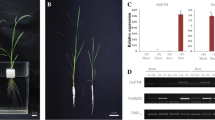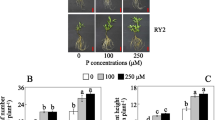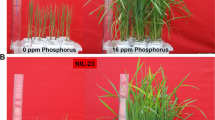Abstract
Phosphorus (P) is one of the most essential macronutrients required for plant growth. Although it is abundant in soil, P is often the limiting nutrient for crop yield potential because of the low concentration of soluble P that plants can absorb directly. The gene expression profile was investigated in rice roots at 6, 24 and 72 h under low P stress and compared with a control (normal P) profile, using a DNA chip of 60000 oligos (70 mer) that represented all putative genes of the rice genome. A total of 795 differentially expressed genes were identified in response to phosphate (Pi) starvation in at least one of the treatments. Based on the analysis, we found that: (i) The genes coding for the Pi transporter, acid phosphatase and RNase were up-regulated in rice roots; (ii) the genes involved in glycolysis were first up-regulated and then down-regulated; (iii) several genes involved in N metabolism and lipid metabolism changed their expression patterns; (iv) some genes involved in cell senescence and DNA or protein degradation were up-regulated; and (v) some transmembrane transporter genes were up-regulated. The results may provide useful information in the molecular process associated with Pi deficiency and thus facilitate research in improving Pi utilization in crop species.
Similar content being viewed by others
References
Raghothama K G. Phosphate acquisition. Annu Rev Plant Physiol Plant Mol Biol, 1999, 50: 665–693, 10.1146/annurev.arplant.50.1.665, 1:CAS:528:DyaK1MXkt1yktrs%3D, 15012223
Lisa C W, Sebastien P C P R, Alastair H F, et al. Phosphate availability regulates root system architecture in Arabidopsis. Plant Physiol, 2001, 126: 875–882, 10.1104/pp.126.2.875
Föhse D, Classen N, Jungk A. Phosphorus efficiency of plants. II. Significance of root radius, root hairs and cation-anion balance for phosphorus influx in seven plant species. Plant Soil, 1991, 132: 261–272
Bates T R, Lynch J P. Stimulation of foot hair elongation in Arabidopsis thaliana by low phosphorus availability. Plant Cell Environ, 1996, 19: 529–539, 10.1111/j.1365-3040.1996.tb00386.x, 1:CAS:528:DyaK28XktlGgt78%3D
Keerthisinghe G, Hocking P J, Ryan P R, et al. Effect of phosphorus supply on the formation and function of proteoid roots of white lupin (Lupinus albus L.). Plant Cell Environ, 1998, 21: 467–478, 10.1046/j.1365-3040.1998.00300.x, 1:CAS:528:DyaK1cXlt1elsrg%3D
Grierson P F. Organic acids in the rhizosphere of Banksia integrifolia L.F. Plant Soil, 1992, 44: 259–265, 10.1007/BF00012883
Lipton D S, Blancher R W, Blevins D G. Citrate, malate and succinate concentrations in exuduates from P-sufficient and P-starved Medicago sativa L. seedlings. Plant Physiol, 1987, 85: 315–317, 10.1104/pp.85.2.315, 1:CAS:528:DyaL1cXjs1Sk, 16665693
Muchhal U S, Pardo J M, Raghothama K G. Phosphate transporters from the higher plant Arabidopsis thaliana. Proc Natl Acad Sci USA, 1996, 93: 10519–10523, 10.1073/pnas.93.19.10519, 1:CAS:528:DyaK28XlslGrs7Y%3D, 8927627
Muchhal U S, Raghothama K G. Transcriptional regulation of plant phosphate transporters. Proc Natl Acad Sci USA, 1999, 96: 5868–5872, 10.1073/pnas.96.10.5868, 1:CAS:528:DyaK1MXjtFCnu7c%3D, 10318976
Leggewie G, Willmitzer L, Riesmeier J W. Two cDNAs from potato are able to complement a phosphate uptake-deficient yeast mutant: Identification of phosphate transporters from higher plants. Plant Cell, 1997, 9: 381–392, 10.1105/tpc.9.3.381, 1:CAS:528:DyaK2sXitFWqtrs%3D, 9090882
Haran S, Logendra S, Seskar M, et al. Characterization of Arabidopsis acid phosphatase promoter and regulation of acid phosphatase expression. Plant Physiol, 2000, 124: 615–626, 10.1104/pp.124.2.615, 1:CAS:528:DC%2BD3cXnsF2rsL8%3D, 11027712
Baldwin J C, Karthikeyan A S, Raghothama K G. LEPS2, a phosphorus starvation-induced novel acid phosphatase from tomato. Plant Physiol, 2001, 125: 728–737, 10.1104/pp.125.2.728, 1:CAS:528:DC%2BD3MXhs1KlsLg%3D, 11161030
Dodds P N, Clarke A E, Newbigin E. Molecular characterization of an S-like RNase of Nicotiana alata that is induced by phosphate starvation. Plant Mol Biol, 1996, 31: 227–238, 10.1007/BF00021786, 1:CAS:528:DyaK28XltFGltb0%3D, 8756589
Bariola P A, Howard C J, Taylor C P, et al. The Arabidopsis ribonuclease gene RNS1 is tightly controlled in response to phosphate limitation. Plant J, 1994, 6: 673–685, 10.1046/j.1365-313X.1994.6050673.x, 1:CAS:528:DyaK2MXis1Sntbk%3D, 8000425
Stephen M G D, Moorhead G B G, Lefebvre D D. Phosphate starvation inducible ‘bypasses’ of adenylate and phosphate dependent glycolytic enzymes in Brassica nigra suspension cells. Plant Physiol, 1989, 90: 1272–1278
Plaxton W C. The organization and regulation of plant glycolysis. Annu Rev Plant Physiol Plant Mol Biol, 1996, 47: 185–214, 10.1146/annurev.arplant.47.1.185, 1:CAS:528:DyaK28XjtlWgsbg%3D, 15012287
Bergman L W, McClinton D C, Madden S L, et al. Molecular analysis of the DNA sequences involved in the transcriptional regulation of the phosphate-repressible acid phosphatase (PHO5) of Saccharomyces cerevisiae. Proc Natl Acad Sci USA, 1986, 83: 6070–6074, 10.1073/pnas.83.16.6070, 1:CAS:528:DyaL28XlsVOnsb8%3D, 3526349
Lenburg M E, O’shea E K. Signaling phosphate starvation. Trends Biochem Sci, 1996, 21: 383–387, 1:CAS:528:DyaK28XmsleitLg%3D, 8918192
Rubio V, Linhares F, Solano R, et al. A conserved MYB transcription factor involved in phosphate starvation signaling both in vascular plants and in unicellular algae. Genes Dev, 2001, 15: 2122–2133, 10.1101/gad.204401, 1:CAS:528:DC%2BD3MXmt1ajsb8%3D, 11511543
Zakhleniuk O V, Raines C A, Lloyd J C. pho3: A phosphorusdeficient mutant of Arabidopsis thaliana (L.) Heynh Planta, 2001, 212: 529–534, 10.1007/s004250000450, 1:CAS:528:DC%2BD3MXhs1Cgtrg%3D
Chen D L, Delatorre C A, Bakker A, et al. Conditional identification of phosphate starvation-response mutants in Arabidopsis thaliana. Planta, 2000, 211: 13–22, 10.1007/s004250000271, 1:CAS:528:DC%2BD3cXjvVyhs7k%3D, 10923699
Ticconi C A, Delatorre C A, Lahner B, et al. Arabidopsis pdr2 reveals a phosphate-sensitive checkpoint in root development. Plant J, 2004, 37: 801–814, 10.1111/j.1365-313X.2004.02005.x, 1:CAS:528:DC%2BD2cXjtFChur8%3D, 14996215
Maleck K, Levine A, Eulgem T, et al. The transcriptome of Arabidosis thaliana during systemic acquired resistance. Nat Genet, 2000, 26: 403–410, 10.1038/82521, 1:CAS:528:DC%2BD3cXptVWgsbk%3D, 11101835
Kawasaki S, Borchert C, Deyholos M, et al. Gene expression profiles during the initial phase of salt stress in rice. Plant Cell, 2001, 13: 889–905, 10.1105/tpc.13.4.889, 1:CAS:528:DC%2BD3MXjtFajsrw%3D, 11283343
Seki M, Narusaka M, Abe H, et al. Monitoring the expression pattern of 1,300 Arabidopsis genes under drought and cold stresses by using a full-length cDNA microarray. Plant Cell, 2001, 13: 61–72, 10.1105/tpc.13.1.61, 1:CAS:528:DC%2BD3MXjslCrtr0%3D, 11158529
Wang R, Guegler K, Labrie S T, et al. Genomic analysis of a nutrient response in Arabidopsis reveals diverse expression patterns and novel metabolic and potential regulatory genes induced by nitrate. Plant Cell, 2000, 12: 1491–1509, 10.1105/tpc.12.8.1491, 1:CAS:528:DC%2BD3cXmsVyjsbs%3D, 10948265
Lian X, Wang S, Zhang J, et al. Expression profiles of 10,422 genes at early stage of low nitrogen stress in rice assayed using a cDNA microarray. Plant Mol Biol, 2006, 60: 617–631, 10.1007/s11103-005-5441-7, 1:CAS:528:DC%2BD28XktVSgt7k%3D, 16649102
Wasaki J, Yonetani R, Kuroda S, et al. Transcriptomic analysis of metabolic changes by phosphorus stress in rice plant roots. Plant Cell Environ, 2003, 26: 1515–1523, 10.1046/j.1365-3040.2003.01074.x, 1:CAS:528:DC%2BD3sXotFyqsr8%3D
Hammond J P, Bennett M J, Bowen H C, et al. Changes in gene expression in Arabidopsis shoots during phosphate starvation and the potential for developing smart plants. Plant Physiol, 2003, 132: 578–596, 10.1104/pp.103.020941, 1:CAS:528:DC%2BD3sXkslersbo%3D, 12805589
Wu P, Ma L, Hou X, et al. Phosphate starvation triggers distinct alterations of genome expression in Arabidopsis roots and leaves. Plant Physiol, 2003, 132: 1260–1271, 10.1104/pp.103.021022, 1:CAS:528:DC%2BD3sXlsFGhtLo%3D, 12857808
Misson J, Raghothama K G, Jain A, et al. A genome-wide transcriptional analysis using Arabidopsis thaliana affymetrix gene chips determined plant responses to phosphate deprivation. Proc Natl Acad Sci USA, 2005, 102: 11934–11939, 10.1073/pnas.0505266102, 1:CAS:528:DC%2BD2MXpsFGgu7w%3D, 16085708
Yoshida S, Forno D A, Cook J H, et al. Laboratory Manual for Physiological Studies of Rice. Manila: International Rice Research Institute, 1976. 61–67
Duff S M G, Sarath G, Plaxton W C. The role of acid phosphatase in plant phosphorus metabolism. Physiol Planta, 1994, 90: 791–800, 10.1111/j.1399-3054.1994.tb02539.x, 1:CAS:528:DyaK2cXivFCjtbk%3D
Ueki K. Control of phosphatase release from cultured tobacco cells. Plant Cell Physiol, 1978, 19: 385–392, 1:CAS:528:DyaE1cXkt1SmtLg%3D
Ascencio J. Acid phosphatase as a diagnostic tool. Commun Soil Sci Plant Anal, 1994, 25: 1553–1564, 10.1080/00103629409369135, 1:CAS:528:DyaK2cXjt1ajsbo%3D
Goldstein A H, Danon A, Baertlein D A, et al. phosphate inducible metabolism in Lycopersicon esculentum: Excretion of acid phosphatase by tomato and suspension-cultured cells II. Plant Physiol, 1988, 87: 711–715, 10.1104/pp.87.3.711, 1:CAS:528:DyaL1cXltV2ns70%3D, 16666212
Green P J. The ribonucleases of higher plants. Annu Rev Plant Physiol Plant Mol Biol, 1994, 45: 421–445, 10.1146/annurev.pp.45.060194.002225, 1:CAS:528:DyaK2MXhslKqsQ%3D%3D
Nakamura Y, Awai K, Masuda T, et al. A novel phosphatidy lcholine-hydrolyzing phospholipase C induced by phosphate starvation in Arabidopsis. J Biol Chem, 2005, 280: 7469–7476, 10.1074/jbc.M408799200, 1:CAS:528:DC%2BD2MXhs1yisrs%3D, 15618226
Frentzen M. Phosphatidylglycerol and sulfoquinovosyldiacylglycerol: Anionic membrane lipids and phosphate regulation. Curr Opin Plant Biol, 2004, 7: 270–276, 10.1016/j.pbi.2004.03.001, 1:CAS:528:DC%2BD2cXjvVams7c%3D, 15134747
Prasad R, Dewerqifosse P, Goffeau A, et al. Molecular cloning and characterization of a novel gene of Candida albicans, CDR1, conferring multiple resistance to drugs and antifungals. Curr Genet, 1995, 27: 320–329, 10.1007/BF00352101, 1:CAS:528:DyaK2MXkvFOjs7o%3D, 7614555
Smalle J, Vierstra R D. The ubiquitin 26s proteasome proteolytic pathway. Annu Rev Plant Biol, 2004, 55: 555–590, 10.1146/annurev.arplant.55.031903.141801, 1:CAS:528:DC%2BD2cXlvFeisb4%3D, 15377232
Cogliatti D H, Clarkson D T. Physiological changes in, and phosphate uptake by potato plants during development of, and recovery from phosphate deficiency. Physiol Plant, 1983, 58: 287–294, 10.1111/j.1399-3054.1983.tb04183.x, 1:CAS:528:DyaL3sXks12lsrs%3D
Schachtman D P, Reid R J, Ayling S M. Phosphorus uptake by plant: from soil to cell. Plant Physiol, 1998, 116: 447–453, 10.1104/pp.116.2.447, 1:CAS:528:DyaK1cXht1ajtbc%3D, 9490752
Drew M C, He C-J, Morgan P W. Decreased ethylene biosynthesis, and induction of aerenchyma, by nitrogen- or phosphate-starvation in adventitious roots of Zea mays L. Plant Physiol, 1989, 91: 266–271, 10.1104/pp.91.1.266, 1:CAS:528:DyaL1MXmtFert7o%3D, 16667008
Author information
Authors and Affiliations
Corresponding author
Additional information
Supported by the National Key Basic Research and Development Program of China (Grant No. 2005CB120905).
Rights and permissions
About this article
Cite this article
Li, L., Qiu, X., Li, X. et al. The expression profile of genes in rice roots under low phosphorus stress. SCI CHINA SER C 52, 1055–1064 (2009). https://doi.org/10.1007/s11427-009-0137-x
Received:
Published:
Issue Date:
DOI: https://doi.org/10.1007/s11427-009-0137-x




